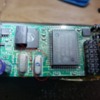@gunrunnerjohn posted:I have to smile here, I have a whole box of dead 5V boards, and I have no desire to work on them. Paul, you can have them for the cost of shipping!
So did the box of dead 5V boards change hands?
If sitting on a pile of dead 5V boards with goal of fixing several/many,
1) I'd want to know if you can you power up JUST the smaller power supply board and reach some confidence level that it is working? You'd think you could at minimum confirm a few different voltages.
2) Then, I'd think some kind of test fixture or test connector/harness would be handy that can mate the two boards with more separation than the final connectors. In other words, something where you can probe/measure voltages on both sides of BOTH boards mated and powered. This might entail some effort to make a clamp or whatever with spring-loaded "pogo" pins or the like.











